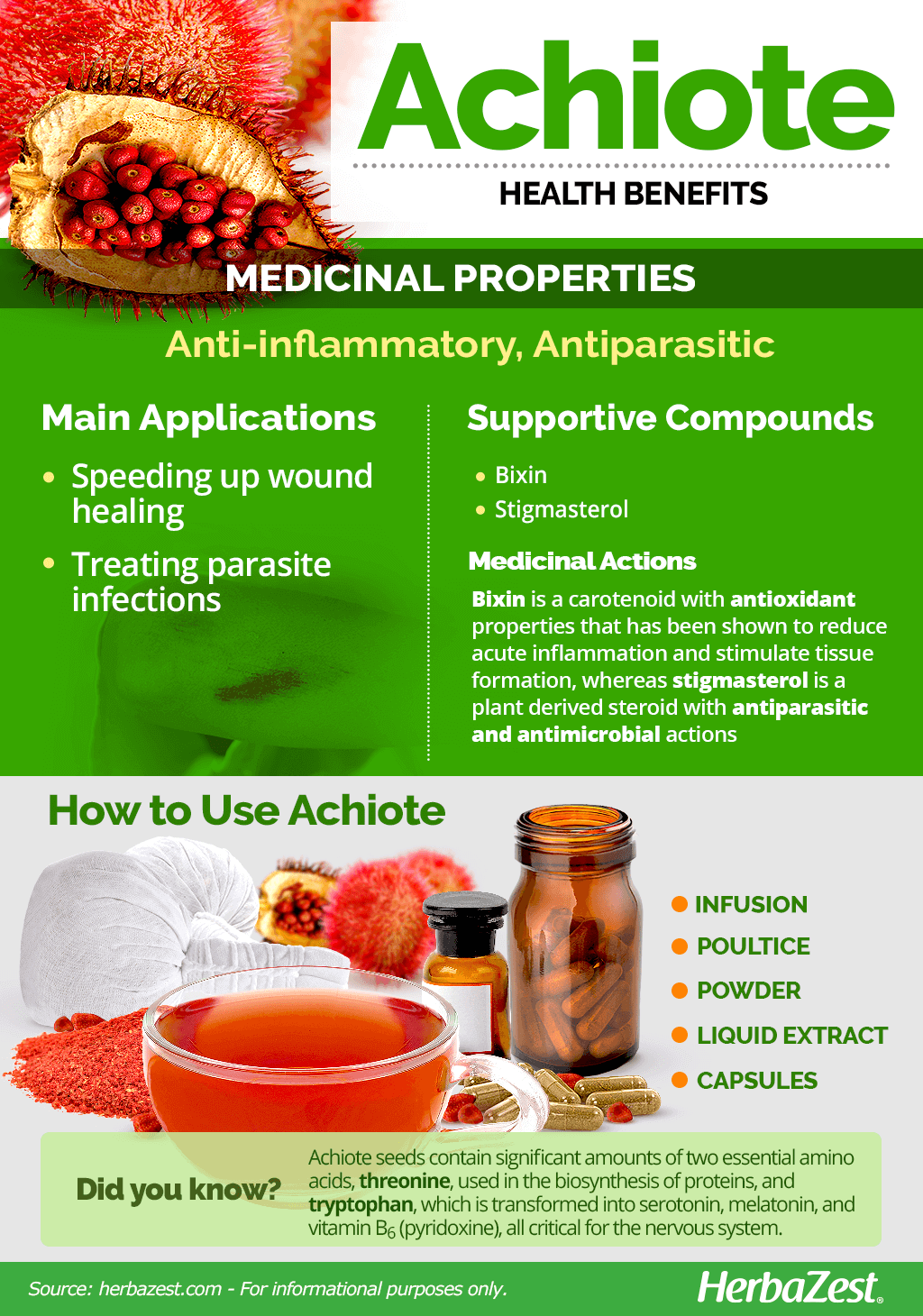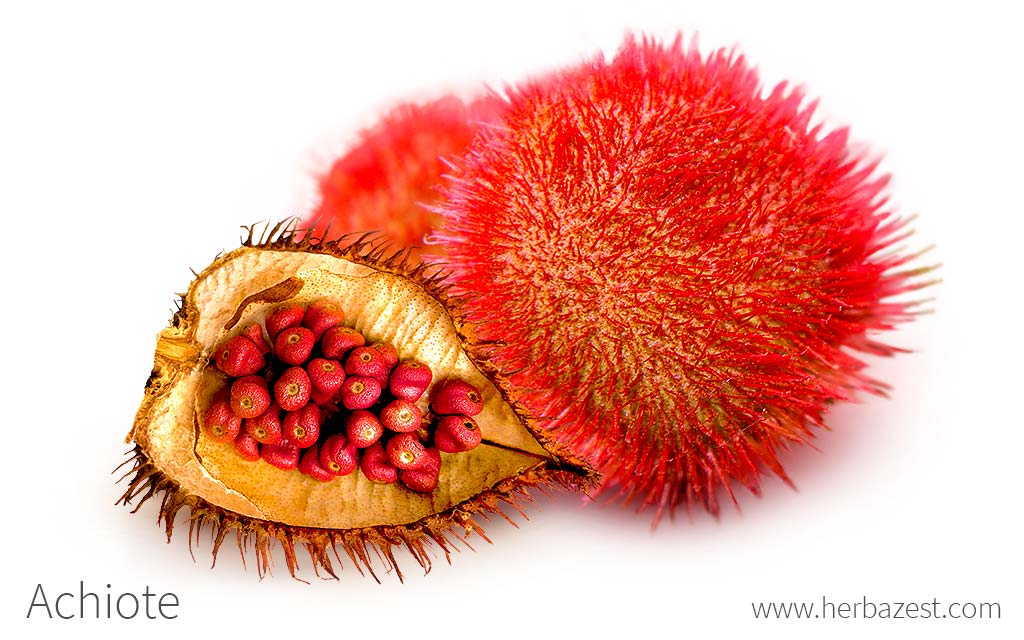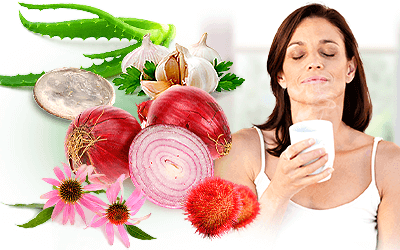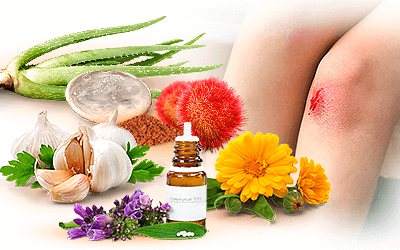Achiote may be lesser known among the common household spices, but this fragrant and colorful herb can actually be found in many homes around the world, either explicitly added for cultural significance or subtly present as a dye in processed foods. Its nuanced presence, however, belies its original use as a powerful natural medicine.
Achiote Medicinal Properties
Health Benefits of Achiote
The unique combination of bixin, antioxidants, and tannins found in achiote seeds can provide the following medicinal benefits:
Speeding up wound healing. Like most carotenoids, bixin possesses strong anti-inflammatory action, which can soothe burns and blisters on the skin when applied topically.
Treating parasite infections. Achiote is popularly used to eliminate parasites and seems to be particularly effective for relieving the symptoms of malaria.
In addition, the bark and root of achiote has been traditionally used to reduce fever, inflammation, and stomach infections.
How It Works
Over two dozen substances have been isolated from the seeds of achiote, also known as annato; however, the industrial and medicinal importance of this herb comes from the high amounts of carotenoids contained in the seeds1. Achiote seeds are particularly rich in a orange-red colored pigment called bixin, which is present at levels as high as 80%, but they also contain orellin, which is a yellow pigment.
Although its mechanisms of action are yet to be fully explained, in vitro experiments have linked bixin to the high antioxidant capacity of achiote seed, which may play a role in its anti-inflammatory and wound healing properties2. Bixin has also been shown to intercept free radicals generated by commonly used chemotherapeutic drugs, and some studies suggest that supplementation with beta-carotene and achiote can help manage diabetes.
In addition, achiote seeds contain significant amounts of two essential amino acids: threonine, used in the biosynthesis of proteins, and tryptophan, which is transformed into serotonin, melatonin, and vitamin B6 (pyridoxine), all critical for the well-functioning of the nervous system. The nutritional value of achiote is intensified by the presence of vitamin E (as tocotrienol)2, as well as different flavonoids, tannins, sterols, and saponins.
Stigmasterol, a plant derived steroid, has been identified as the most potent antiparasitic, antimalarial compound in achiote.3,4
Anti-inflammatory properties are also present in aloe and greater plantain, whereas elecampane and papaya seeds can provide similar antiparasitic benefits.
Side Effects
Achiote is considered generally safe; however, it can cause allergic reactions in sensitive people. Symptoms include anaphylactic shock and hives.
Overconsumption of achiote can cause diarrhea and gastrointestinal discomfort.
Cautions
Although no drug or supplement interactions have been reported for achiote, the herb has shown hypoglycemic effects, so diabetics under glucose control medication are advised to consult to a health professional before consuming achiote in medicinal doses.
While no adverse reactions have been reported, because of the lack of information on achiote during pregnancy and breastfeeding, it is advised to limit the consumption of the herb in women going through these stages.
- Medicinal action Anti-inflammatory, Antiparasitic
- Key constituents Bixin, stigmasterol
- Medicinal rating (1) Very minor uses
- Safety ranking Safe
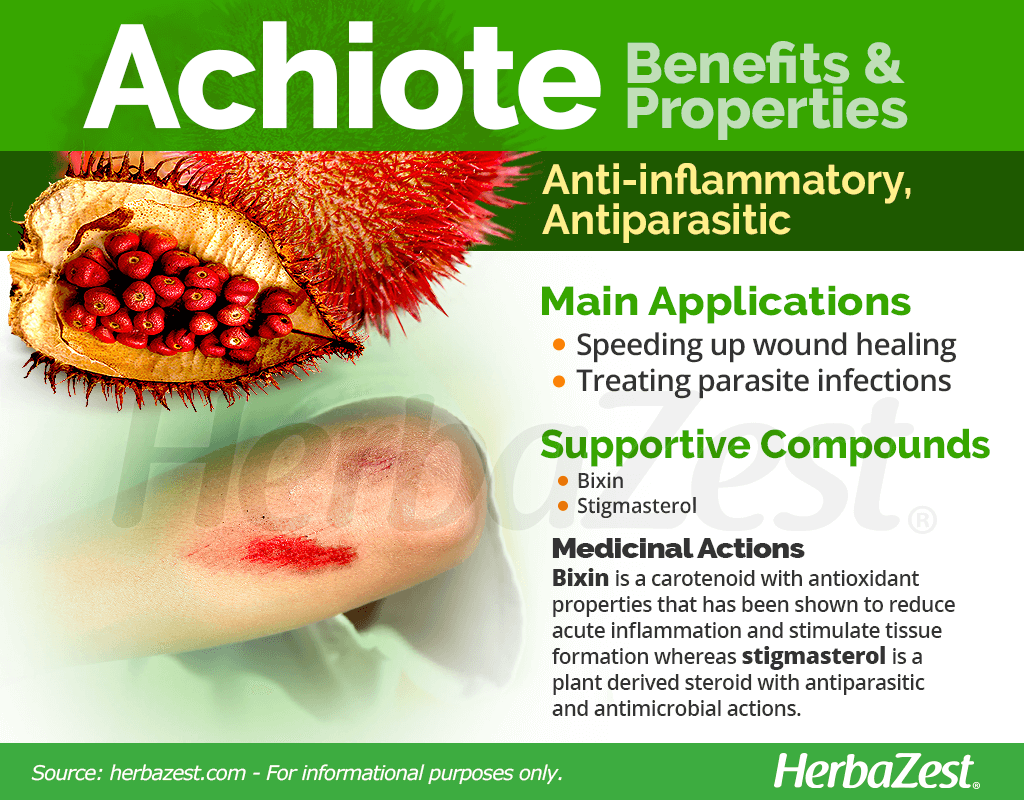
How to Consume Achiote
Achiote is mostly used for culinary purposes; however, it is rich in anti-inflammatory and antioxidant compounds, and various medicinal preparations are meant to take advantage of these properties.
Natural Forms
Infusion. In traditional medicine, achiote tea made from the plant's roots and leaves has been used to relieve respiratory inflammation, such as a sore throat.
Poultice. The seed's pulp has been applied traditionally to burns and wounds.
Powder. Achiote's seed powder or paste is used as a seasoning and coloring, especially in Latin American food. It is unclear whether or not the amount typically consumed in dishes is sufficient to provide anti-inflammatory benefits.
Herbal Remedies & Supplements
Liquid extract. This preparation concentrates the medicinal properties of achiote seeds and can be taken daily, typically diluted in a glass of water.
Capsules. This preparation offers controlled dosage of the herb. They are typically taken to reduce inflammation or for their antioxidant properties.
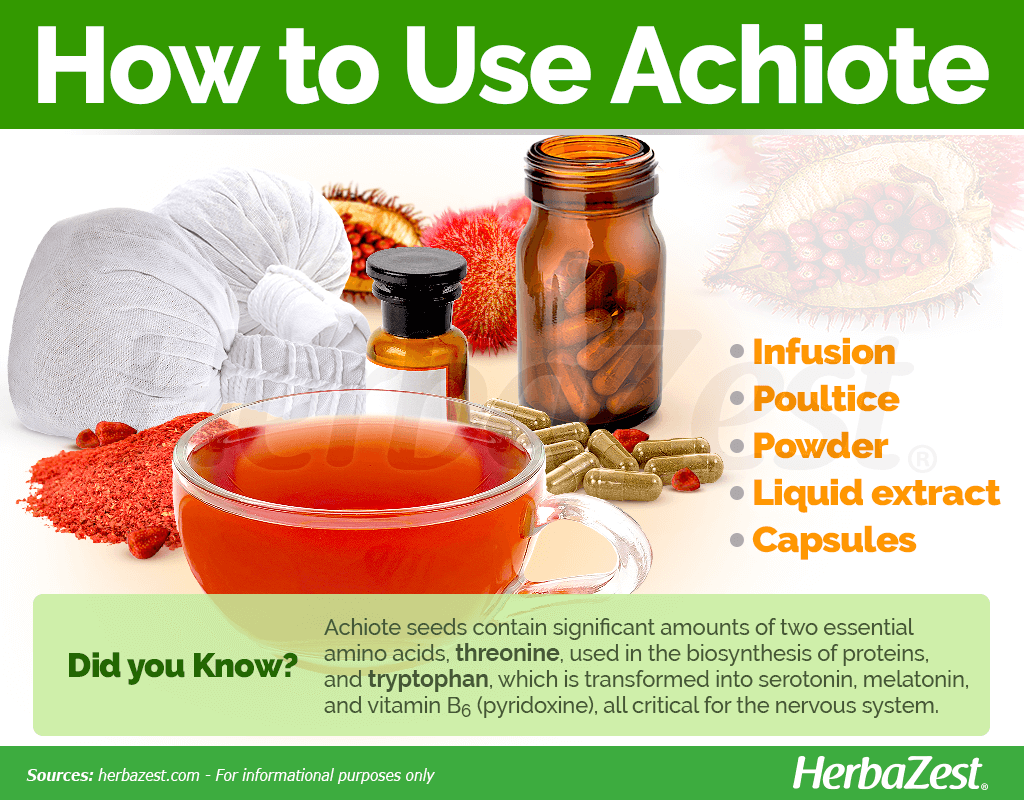
Growing
A tropical perennial shrub, achiote, annatto, or lipstick tree, is grown mostly as an industrial crop, although in India, where conditions are conducive to its propagation, it is also cultivated as an ornamental plant.
Growing Guidelines
Temperatures between 82 - 112°F (28 - 44°C) and ten hours of daily sunlight are required for proper development.
Precipitation levels should, ideally, range from 31 - 59 inches (800 - 1,500 mm) each year.
Slightly acidic soil that offers good drainage works best, and flowers and fruit start to form three years after planting.
Stable plants can live for 20 - 25 years.
- Life cycle Perennial
- Harvested parts Seeds
- Light requirements Full sun
- Soil pH 6.1 – 6.5 (Slightly acidic)
- Growing habitat Tropical rainforests
Additional Information
Plant Biology
Achiote is an evergreen that can grow up to 25 feet (7.6 m) tall and has large, broad leaves and pink or white flowers. Its red, spiny fruit can either be smooth or found covered in dense bristles. When ripe, approximately 50 seeds and a red seed pulp are harvested from within.
Classification
Achiote (Bixa orellana) is a member of the Bixaceae family and, as the most famous of over 25 species, its name is sometimes used as a colloquial umbrella term for this diverse group of trees and shrubs.
Varieties and Subspecies of Achiote
There are three varieties of achiote in existence today, differentiated by the colors of their flowers and seeds. However, these do not have specific names, and there are no true subspecies, given that the change in genetic composition is so slight. Trees that feature white flowers tend to produce seeds with green capsules; those with purple flowers come with brownish-red capsules; and those with pink flowers yield capsules of a truer shade of red. Difference in color appears to have no bearing on medicinal efficacy or taste.
Historical Information
Achiote was well-established in human culture well before its official discovery, though records don't indicate exactly how far back its use stretches. It is known, however, that the herb was prized by Mayan and Aztec civilizations and used as part of religious ceremonies as a representation of blood. It was also employed as a cosmetic, body paint, food dye, and herbal medicine.
European discovery by Spanish and Portuguese settlers led to the introduction of achiote into the Western world, though it continued to remain more popular in imperial colonies, taking root in India, Sri Lanka, and even Eastern Africa.
Economic Data
Despite the little publicity that achiote receives, today it is a thriving part of international crop cultivation, used mainly for manufacturing Annatto Red, a very popular food coloring. The annual world production of achiote seeds is of approximately 14,500 tons (dry weight), from which two thirds is commercialized as dried seeds and the rest as colorant.
Latin America produces 60% of the total world production, followed by Africa (27%) and Asia (12%). The main producers in Latin America are Brazil and Perú, yielding roughly 5,500 tons of the plant's seed each year. The U.S. imports approximately 40% of the world's supply, since the country's Food and Drug Administration (FDA) does not require annatto dyes to be certified for use.
Other Uses
Insect repellent. A multipurpose plant, achiote has found diverse other uses over the years, including deterring insects.
Dye. Achiote is also used as a natural dye for cloth and leather.
Cosmetics. Achiote also works as a natural cosmetic, and it is known as "the lipstick tree" for this reason. The seed's paste is dotted on women's foreheads as a sign of marriage.
Sunscreen. The plant has proven to be an effective nontoxic sunscreen, protecting the skin from the damaging effects of UV rays.
Fodder. In some areas, the fruit of the achiote tree is used for animal fodder.
Fuel. The bark of achiote is quite flammable and it is used as a source of fuel in some places.
Gardening. In India, the tree itself is a popular ornamental plant.
Food industry. The bixin contained in the pulp of achiote is widely used for making natural food colorants.
Sources
- American Herbal Products Association's Botanical Safety Handbook, p. 136
- Indian Journal of Fundamental and Applied Life Sciences, Food Ethanobotanical and Diversified Applications of Bixa orellana L.: A Scope for its Improvement through Biotechnological Mediation
- Preventive Veterinary Medicine, Medicinal plants used for dogs in Trinidad and Tobago
- Revista da Universidade Vale do Rio Verde, Evaluation of antiparasitic activity of hydroethanolic extracts from root, stem and leaf of Bixa orellana L. on Leishmania amazonensis samples
- The Scientific World Journal, Traditional Uses, Chemical Constituents, and Biological Activities of Bixa orellana L.: A Review, 2014
- Encyclopedia of Herbal Medicine, p. 178
- FAOSTAT, Annatto Extracts: Chemical and Technical Assessment
- Phytotherapy Research, Safety and efficacy of Bixa orellana (achiote, annatto) leaf extracts, 2014
- Journal of Nutritional Science and Vitaminology, Dose dependent elevation of plasma tocotrienol levels and its effect on arterial compliance, plasma total antioxidant status, and lipid profile in healthy humans supplemented with tocotrienol rich vitamin E
Footnotes:
- Frontiers in Plant Science. (2016). Carotenoid Derivates in Achiote (Bixa orellana) Seeds: Synthesis and Health Promoting Properties. Retrieved June 18, 2020 from https://pubmed.ncbi.nlm.nih.gov/27708658/
- Journal of Food Science and Technology (2017). Achiote (Bixa orellana L.): a natural source of pigment and vitamin E. Retrieved June 18, 2020 from https://www.ncbi.nlm.nih.gov/pmc/articles/PMC5430180/
- Asian Pacific Journal of Tropical Biomedicine. (2016). Antibacterial activity of Bixa orellana L. (achiote) against Streptococcus mutans and Streptococcus sanguinis. Retrieved June 18, 2020 from https://www.researchgate.net/publication/298916806_Antibacterial_activity_of_Bixa_orellana_L_achiote_against_Streptococcus_mutans_and_Streptococcus_sanguinis
- Molecules. (2014). Antimalarial Evaluation of the Chemical Constituents of Hairy Root Culture of Bixa orellana L. Retrieved June 18, 2020 from https://pubmed.ncbi.nlm.nih.gov/24406786/
